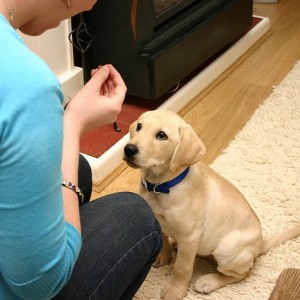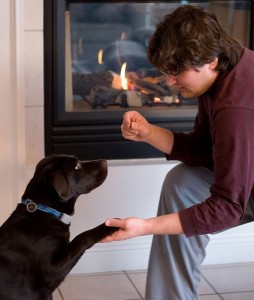 We used to call them “commands.” Actually many dog owners and trainers still call them that. I’m talking about those things we say and do in order to get our dogs to perform the behaviours we trained them to do. You would think that it’s a relatively uncomplicated thing to put a name or signal on something like “Sit” or “Down.” In practice, it’s more complex than you might realize.
We used to call them “commands.” Actually many dog owners and trainers still call them that. I’m talking about those things we say and do in order to get our dogs to perform the behaviours we trained them to do. You would think that it’s a relatively uncomplicated thing to put a name or signal on something like “Sit” or “Down.” In practice, it’s more complex than you might realize.
Dogs are, for all their compatibility with us, a different species. Their remarkable ability to work out what we are trying to communicate with them can sometimes work against them. We can assume too much about what our dog does and doesn’t understand. Many owners and trainers also make the mistake of thinking that dogs can reason things out like humans can. So the process of explaining what a word or signal means to our dog seems pretty easy until our dog fails to perform when we give our “command.” That’s when things can get strange.
That’s my cue
I prefer the term “cue” for the words and signals we give to our dogs when we want a behaviour. It seems more in tune with the way dogs actually think. A “cue” is a signal that something is happening. There is an opportunity available. If you are a positive trainer, a “cue” would indicate that something good is on offer if the signalled behaviour is performed. If you are a more traditional, force-based trainer, a cue would indicate that there is opportunity to avoid a correction if the signalled behaviour is performed. The contrast I’m making here might not be an obvious one. Given how dogs think, it’s unlikely that your dog understands that the word “Sit” means that they are to put their butt on the floor. Instead, they take that word as a signal that there is an opportunity to either earn a reward or avoid a correction if they put their butt on the floor.
That distinction may sound a little foggy so let me put it another way. Dogs do not understand that when you say “Sit” that you want them to sit. They understand that there is an opportunity for them to affect what comes next after the signal is given. To a human, it may seem like the same thing but to a dog it isn’t. And the difference shows up if the dog does not perform the behaviour. If we think the dog understands what we want when we say “sit”, then if they don’t sit, it must be something personal. Call it defiance, disobedience, or stubbornness but the dog is not doing what we asked.
From the dog’s point of view, they had an opportunity and either took advantage of it or not. It wasn’t about the handler’s wishes, it was about how the outcome would affect the dog. There was nothing personal in it at all! The dog was not being disobedient, they just chose not to take advantage of that opportunity. And that changes things considerably. Either the potential reward or the potential correction were not sufficiently motivating for the dog to choose to do the behaviour that was cued.
We humans are a verbose bunch. Certainly compared to dogs we are! We seem to have words for EVERY thing. In many cases, we have more than one word for the same thing. But our big human brains with their giant cerebral cortex can keep all of those words straight and manage the slight variations that each word might indicate. Many dog owners bring that human habit into their relationship with their dogs. “Come”, “Here”, and even the dog’s name could all mean the same thing – bring yourself over to me. Add to that the wave of a hand, walking away from the dog, or even just flicking the head and there are multiple cues to get a dog to bring themselves over to the handler.
Fortunately, that’s not necessarily a bad thing. One of the things we know about dogs is that you can have more than one cue for the same behaviour. Dogs can figure that out just fine. As long as you take the time to teach them each of the signals that you want to use, the dog should respond to any of them by offering the trained behaviour. Most dog owners have at least one word and one hand signal for common behaviours like “Sit” and “Stay.”
Where things begin to break down is when we have one cue for more than one thing. For example, if I say “Sit” to my dog, do I mean sit and stay there until I tell you to get up or does it mean touch your butt to the floor and I’ll let you decide when to get up? If we’re not clear about these things, it gets very confusing for the dog. We say “Sit” and they sit, we let them get up and reward the behaviour. The next time we’re showing off at training class and the dog gets up after we say “Sit”, we give them a correction for not staying until we release them. So which is it? Being clear and consistent in our training avoids these situations where we use the same word for different criteria.
Teaching cues
It can be tricky to teach a dog a cue for a behaviour. I shake my head and marvel any time I watch an owner with a new puppy just pulling up on the leash and saying “Sit! Sit! SIT!” to their dog. What are they actually communicating to the dog? Does “Sit” mean they are pulling up on the leash? Does it mean the leash itself? Does it mean look at the owner? Eventually the puppy works it out after some trial and error. But there’s a better way to teach cues. Saying the cue we want before the dog does the behaviour has proven to be less than efficient. As author and animal trainer Karen Pryor once suggested, it’s like singing in the ear of a child trying to work out an algebra problem. The word is just distracting them from discovering what it is you want.
 Think about how we teach children the names for objects. We show them an apple and say “Apple.” It should be the same when we teach our dog a cue. Once the dog sits the way we want, then we give them a word for it. This may sound strange to some people. How do you get a dog to sit if you don’t say “Sit”? Well, the dog doesn’t know what “Sit” means anyway so why not do it without using any word at all? If you just reward the dog when they sit enough times, they will begin to offer it to you on their own. And that’s the perfect time to introduce your new cue. That thing you are doing right now? That’s called “Sit.” Much like showing a child an apple and saying “Apple.”
Think about how we teach children the names for objects. We show them an apple and say “Apple.” It should be the same when we teach our dog a cue. Once the dog sits the way we want, then we give them a word for it. This may sound strange to some people. How do you get a dog to sit if you don’t say “Sit”? Well, the dog doesn’t know what “Sit” means anyway so why not do it without using any word at all? If you just reward the dog when they sit enough times, they will begin to offer it to you on their own. And that’s the perfect time to introduce your new cue. That thing you are doing right now? That’s called “Sit.” Much like showing a child an apple and saying “Apple.”
Many of the problems people have with their dogs responding to their cues are related to not carefully teaching what the cue means. You must remove any ambiguity in the meaning of the cue. You can do that by many repetitions over time and let the dog learn or you can set up the training to remove all distractions before introducing the cue. And then, of course, you have to be consistent in how you use that cue and that you reinforce it.
Across the cultural divide
Dogs do not use language. Humans try to make things happen. Dogs see the results of their actions and decide if they were a good idea or not. It seems to me like the first thing we need to do in working with our dogs is to acknowledge the differences between us and how we approach the world. Asking a dog to understand human language is like asking a human to understand how dogs view the world. Dogs constantly observe and evaluate every action and its consequence in minute detail. We just don’t approach life the same way. A little understanding can go a long way.
If we can adjust our expectations by trying to understand the mindset of our dogs, we can be much better at teaching cues to our dogs and using them effectively. If we can set aside our human bias and understand that dogs aren’t being “disobedient” or “stubborn” then we can take the emotional sting out of those times when our dogs just don’t respond to our cues. I have found in my own work with dogs that doing those things allows me to focus on what I need to do to help my dogs succeed rather than dwelling on the failures.
After all, a missed cue is not an act of insubordination in the way that disobeying an command would be. A missed cue is just a lost opportunity. We’re free to create as many opportunities as we want. There is always another chance to succeed when opportunity comes your way!
Until next time, have fun with your dogs.
The first Canine Nation ebook is now available –
“Dogs: As They Are”
Photo credits –
Sit!- colorblindPICASO 2006 From Flickr
Shake! – nikitab 2007 From Flickr
Teaching – Ross Burton 2006 From Flickr


 In the Canine Nation Store!!!
In the Canine Nation Store!!! 

Sooooo…..when my dog does not respond to my cue, she has done a quick cost/benefit analysis of doing the behaviour I’m looking for and decided that the costs outweigh the benefits? That may be a reason to add a little incentive by way of “correction”. Or perhaps I could practice making the behaviour so darn rewarding that there is nothing she would rather do than what I have asked of her. Sounds like a lot of work. But as one who strives to live by option B, so very very rewarding, for me and my dog.
Thanks again for another great article, Eric and for being the person who showed me the better way.